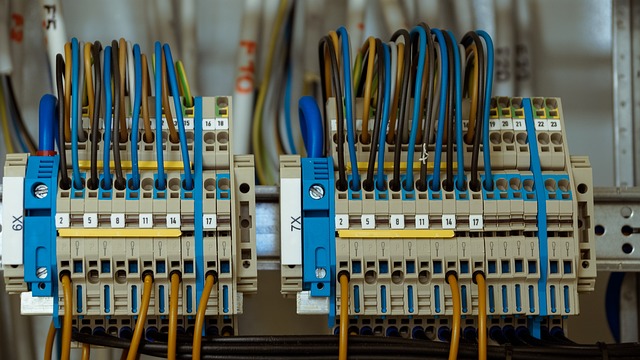 Contactors are a kind of electrical switch used in the switching of electrical circuits. Commonly used in large motors, they’re useful for various purposes in industry, including protecting motors from overload conditions or overcurrent within the motor. To do their job correctly, the contactor’s power rating must be greater than that of the circuit to which it’s connected.
Contactors are a kind of electrical switch used in the switching of electrical circuits. Commonly used in large motors, they’re useful for various purposes in industry, including protecting motors from overload conditions or overcurrent within the motor. To do their job correctly, the contactor’s power rating must be greater than that of the circuit to which it’s connected.
While typically, relays and switches connect indirectly to the circuit, contactors attach directly to the circuit. Switching devices that handle a current rating of greater than 15 amps are commonly known as contactors, which are usually used as switching devices for the motor. Contactors control and suppress the arc produced by heavy motors and are used to control the current flow. While the contactor controls this flow of electricity, it also can be termed as a relay, which, along with various relays and contactors within a motor, performs the basic operation of switching electrical current on and off.
How to Choose a Contactor
Essentially, a contactor is a mechanical switching device for an electrical circuit controlled by a coil. This coil is an electromagnet that opens or closes an electrical circuit under load, a task that a contactor helps carry out. The contactor’s main contacts, also known as main poles, are what does this switching. Typically, contactors are designed for either AC or DC voltage through the contacts.
A contactor is similar to a relay, though differs in that it can work at higher voltages and currents. A number of analyses should be done to determine how to choose a contactor that’s most suitable for a specific electric motor or application. These include the load type and duty cycle of the motor, along with the amount of current the motor draws. The type of motor or application also plays a significant part in how to choose a contactor, especially when it comes to sizing the contactor.
Utilization Category
The type and duty cycle of an electrical load are what’s known as the utilization category. These are defined through standards developed by the International Electrotechnical Commission (IEC). The IEC is a nonprofit organization tasked with preparing and publishing international standards for rating electronic and electrical technologies. Using utilization categories or codes, IEC standards help determine which contactor to use by defining the electrical characteristics of each.
Load Type
The rotational effects of a motor create what’s called an inductive load. Meanwhile, resistive loads occur when electricity is used to produce heat, motion or both. When looking at how to choose a contactor for a motor or other electrical device, it’s important to look at the manufacturer’s datasheet or catalog. Generally, the more a device is turned on and off, the larger the contractor should be.
Duty Cycle
Also sometimes called the “duty factor,” the ratio of time a load or circuit is off compared to the time it’s on is known as the duty cycle. Expressed as the percentage of time in the on position, an example of this would be a pulse lasting .08 second of a .1 second cycle. This would translate to an 80 percent duty cycle.
Electrical Properties
As the electrical properties of a motor show, to choose a contactor requires looking at the details of a motor’s listed current, power and voltage. Motors come with datasheets or tags that help with this selection process, listing their properties in order to make selecting the correct contactor easier.
The positioning of a motor’s electrical supply is another factor to consider when picking a contactor. Most industries use a three-phase 400V supply, though some use 110V instead, with certain heavy industries using 690V electrical supplies. The rated current for the contactor varies, depending on the voltage, so it’s important when choosing a contactor to ensure it will work with the voltage being supplied.
Choosing the Correct Contactor Size
When it comes to sizing, it’s important when looking at how to choose a contactor to look not only at the type of motor, but also to consider the application. The exact same motor used for different purposes may very well require two different contactors. For example, applications that require a motor to be turned on and off frequently will generally need a larger contactor due to the higher current loads during startup, whereas for a motor left turned on for long periods at a time a smaller contactor would be sufficient.
Sizing a contactor involves:
- Amount of current required to power the motor at the line voltage, also known as load amperage.
- Confirming control voltage for powering contactor, which are typically 250V or less.
- Determining the specific nature of the electrical load and its duty cycle.
- Number of auxiliary contacts that remain mostly open or closed, which are often added to the configuration to allow additional operations that can save time and money.
- Whether the motor operates in reverse, as reversing contactors require two contactors; this utilizes a contactor for each direction the motor runs, along with either an electrical or mechanical interlock, or both, to ensure a contactor is always energized.
Using the wrong size contactor will diminish the contactor lifespan, so it’s important to choose a correctly sized one.
Other Key Considerations for How to Choose a Contactor
Three other elements that ought to be considered when choosing a contactor are its main
contacts, auxiliary contacts and the coil. The main contacts carry the current, while auxiliary contacts are used for controlling and signaling the circuits. The coil is used to energize the contactor in order to switch the main contacts on and off.
Main Contacts
The current that partly carries through the contactor operates on either AC or DC voltage. The switching current rate is measured in amps and, when selecting contactors, it’s important to note the number of these that are normally opened or closed. This should be based on the starting and stopping cycles of operation, along with whether the load is resistive or inductive.
Auxiliary Contacts
Auxiliary contacts also note the number of contacts that are normally in open or closed configurations. These contacts aren’t necessarily rated for the same current as the main contacts, with certain models even utilizing a time delay. Auxiliary contacts are used between circuits and contactors for various functions, which when energized allow additional operations to occur.
Coil Ratings
When looking at how to choose a contactor, coil ratings should be considered.
These ratings are as follows:
- Drop-out voltage for the contactor occurs when all contactor switches are in nonoperating positions.
- Operating current of the rated coil voltage.
- Pick-up voltage occurs when all switches are in their operating positions.
- Rated coil voltage for the contactor should equal the voltage of the circuit that powers the coil.
Other factors
In addition to all these factors involved in choosing a contactor, other aspects like environmental conditions and ambient temperatures should be considered. Whether a motor’s design is modular or standalone also affects the choice of contactor, while the need for busbars, coil surge suppressors, enclosures, interlock devices, or timers should also be considered.
To learn more about choosing a contactor for your motor, contact the experts at Springer Controls Company, or if you already know what you need, request a quote today.
